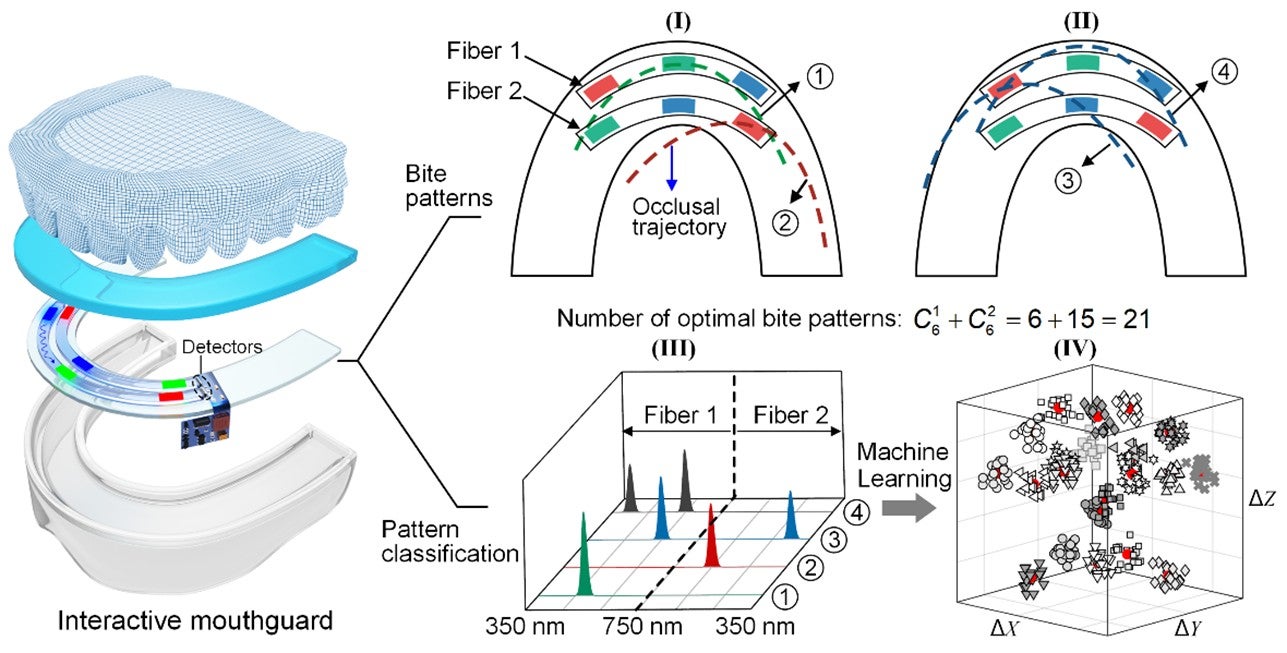Mechanoluminescence-powered smart mouthguard for healthcare assistance and human–computer interaction
October 11, 2022NUS researchers have developed an unprecedented, interactive mouthguard using mechanoluminescence-powered optical fibre array for controlling electronic devices.
The operation of smart electronic devices such as computers and motorised wheelchairs is essential but may be difficult for individuals with limited dexterity or neurological disorders. Many assistive technologies suffer from problems related to device use and maintenance. For example, voice recognition requires a large computer memory and a low-noise operating environment; eye tracking requires a camera that must be mounted in front of the user and is prone to user fatigue. Brain–computer interfaces have considerably improved in recent years, but the technology requires cumbersome wired instruments and a high degree of invasiveness.
A research team led by Professor LIU Xiaogang from the Department of Chemistry, National University of Singapore demonstrated a bite-controlled optoelectronic system that uses mechanoluminescence-powered distributed optical fibre sensors integrated into a mouthguard. By utilising unique patterns of occlusal contacts, the interactive mouthguard can be used to control computers, smartphones, and wheelchairs. The research, conducted with collaborators from Tsinghua University, could be used not only for human–computer interaction, but also for medical applications such as smart skin and dental diagnosis.
The research was published in the journal Nature Electronics.
The researchers designed a mechanoluminescence-powered distributed optical fibre (mp-DOF) sensor that consists of an array of elastomeric waveguides embedded with mechanoluminescent contact pads (see Figure 1). These contact pads contain different coloured phosphors that respond to applied pressure on them. Compression and deformation of the elastomeric mouthguard at specific segments during occlusion is mapped with the mp-DOF by measuring the intensity ratio of different colour emissions in the fibre system. This occurs without the need for external light sources. Unlike conventional electronic pressure sensors, these luminescence-based force sensors are also less susceptible to electromagnetic interference.
More interestingly, they demonstrated that the double-layer mp-DOF sensor can distinguish between different mechanical deformations, including strain, compression and bending. This enables the mp-DOF sensors to be used for multifunctional mechanical sensing applications.
In dental research, the bite force is often used as a parameter to assess masticatory function, and dental occlusion provides high-precision control and requires minimal skill. Inspired by this, the research team integrated the mp-DOF sensors into a custom mouthguard to create a bite-controlled interactive control system. By combining the device with machine learning algorithms, it is possible to translate complex bite patterns into specific data inputs with up to 98% accuracy.
Prof Liu said, “To bring the interactive mouthguard into potential clinical use, it is designed to be light, compact and biocompatible. Weighing less than 7 grams, it offers high force sensitivity and precise control with less training experience when compared to existing assistive technologies.”
“Although the current prototype is designed for well-aligned teeth, a mouthguard with an irregular arrangement of mechanoluminescent pads could also be developed for users with different tooth patterns or for those who are wearing dentures,” added Prof Liu.

Figure 1: Design of the interactive mouthguard based on mechanoluminescence-powered distributed optical fiber (mp-DOF) sensors. Schematic (left) showing the mp-DOF integration into a mouthguard. An array comprising two sets of tricolour mechanoluminescent pads can theoretically generate 21 distinct patterns by biting on one or two of the luminescent pads. (I) and (II) shows four different bite patterns and (III) the corresponding optical spectra for each of them. (IV) By using machine learning techniques, the complex bite patterns can be translated into 21 unique inputs. [Credit: HOU Bo]
Reference
Hou B; Yi L; Li C; Zhao H; Zhang R; Zhou B*; Liu X*, “An interactive mouthguard based on mechanoluminescence-powered optical fibre sensors for bite-controlled device operation” NATURE ELECTRONICS DOI: 10.1038/s41928-022-00841-8 Published: 2022.


